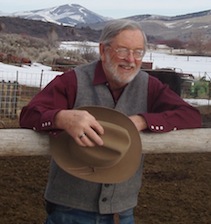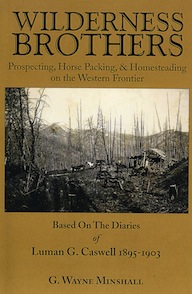Idaho State University Emeritus Professor Minshall pens non-fiction book ‘Wilderness Brothers’ detailing frontier mining life in Idaho’s River of No Return Wilderness
February 27, 2012
Epic journeys, fortunes of gold gained and lost, and plenty of detail about living in the Idaho wilderness during frontier times are chronicled in the new non-fiction book "Wilderness Brothers: Prospecting, Horse Packing, & Homesteading on the Western Frontier," by Idaho State University ecology Professor Emeritus G. Wayne Minshall.
 Minshall's book is based on the diaries Luman G. Caswell wrote from 1895-1903 chronicling his life and those of his brothers Ben and Dan and their close associates A.O. Huntley and Wesley Ritchey. However, Minshall augments the diaries with extensive research and provides an account of the time leading up to and following their discovery of gold on Thunder Mountain, which is located in the current Frank Church River of No Return Wilderness.
Minshall's book is based on the diaries Luman G. Caswell wrote from 1895-1903 chronicling his life and those of his brothers Ben and Dan and their close associates A.O. Huntley and Wesley Ritchey. However, Minshall augments the diaries with extensive research and provides an account of the time leading up to and following their discovery of gold on Thunder Mountain, which is located in the current Frank Church River of No Return Wilderness.
"I read the diaries and became totally immersed in the life they had as homesteaders and miners on Cabin Creek inside of the River of No Return Wilderness," said Minshall, who has spent parts of the last 30 years doing ecological studies in this Idaho wilderness. "I retraced their steps pretty closely, and found their stories very compelling."
The book is geared towards readers of U.S. western history, from those with a general interest to professional scholars.
"The reason they came to Idaho was to look for gold, and, unlike most people, they actually found it," Minshall said. "You wonder, 'if they struck it rich, did they live happily ever after?'"
Read the book if you’re interested in the answer to that question.
 Although the crux of the book is about the period from 1885-1903 in Idaho, it has a much wider scope, dealing with western history from the mid-1860s to the 1960s, encompassing the region from California to Colorado.
Although the crux of the book is about the period from 1885-1903 in Idaho, it has a much wider scope, dealing with western history from the mid-1860s to the 1960s, encompassing the region from California to Colorado.
The book includes information about the Caswells' 2,500-mile odyssey, by buckboard wagon and horseback, from western Colorado, across Utah and Nevada and into Idaho. It also provides information about the Thunder Mountain stampede, triggered by the Caswells' discovery, that was the last major gold rush in the region,
"The emphasis of this account, however, is on self reliance and day-to-day activities and adventures of the times, and not on the rush per se," Minshall said.
In addition, it documents unique aspects of the history of this region and provides a record of land-use practices in the Frank Church River of No Return Wilderness prior to its designation as such.
While at Idaho State University, Minshall taught courses in ecology and conducted research on stream ecosystems. His work has been published extensively in ecological journals.
Minshall has a long abiding interest in "homesteading," in both the historical and modern contexts, as an expression of self-sufficiency and a means of ecological sustainability. He and his wife Judy operate a small farm based on modern, low environmental impact homesteading principles and for more than 10 years he taught a university course based on their experiences.
"Wilderness Brothers" stems from the author’s interest in the self-reliant lifestyle of the pioneer homesteaders and the familiarity gained from many years of research in the Frank Church River-of-No-Return Wilderness.
"Wilderness Brothers," with a list price of $14.95, was published by Streamside Scribe Press and is available from Amazon.com or by emailing streamsidescribe@gmail.com.
####
Categories:
